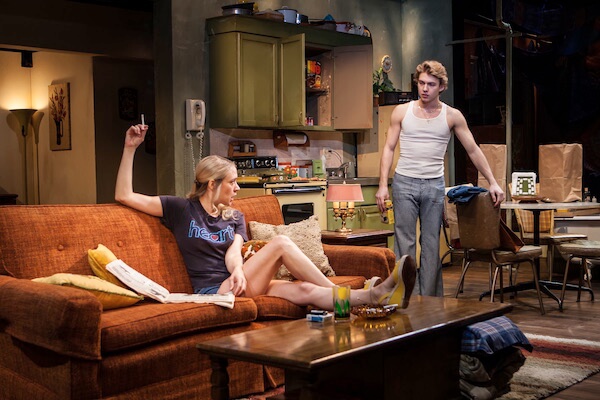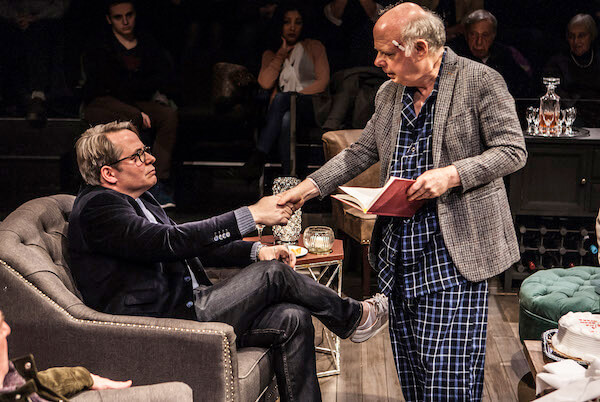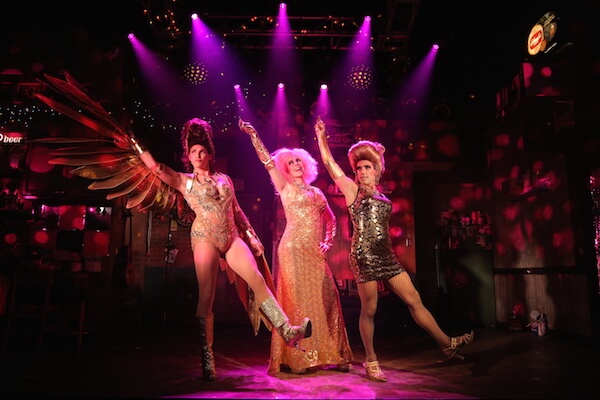Jill Paice and the cast of Richard Thomas and Stewart Lee’s “Jerry Springer — The Opera,” at the Pershing Square Signature Center through April 1. | MONIQUE CARBONI
“Jerry Springer — The Opera” is a joyfully explosive satire of culture both high and low. With music and lyrics by Richard Thomas and the book and additional lyrics by Thomas and Stewart Lee, like the TV show that inspired it, “Springer” is completely over the top.
Thomas and Stewart quite literally recreate “The Jerry Springer Show” in the first act — the wonderful set is by no less than Derek McLane — and then the plot goes gleefully off the rails as Jerry is shot and goes to Hell. The juxtaposition of train wreck TV and Wagnerian myth mines the ridiculousness of both forms and yet does it with such good humor and affection that it’s impossible not to be enchanted. You will marvel at the marriage of outrageous vulgarity and often gorgeous music — and how well it works theatrically.
Four shows where reality — and sanity — are in question
Director John Rando pulls out all the stops and the company revels in the mayhem he’s unleashed. The performers are simply exquisite, all with extraordinary voices and credits in some very serious music. Here, though, they let it all go, with fantastic performances by Luke Grooms as God, Sean Patrick Doyle as the transsexual prostitute love interest who doubles as the Angel Gabriel, Jill Paice as a girl who wants to stay a baby, and Tiffany Mann as Shawntel, the wife who secretly longs to be a pole dancer. As Jerry Springer, Terrence Mann (since replaced through the end of the run by Matt McGrath) doesn’t do much singing, but he does a great impression and holds the center of the piece with style and understated comedy — the only thing understated in this whole undertaking. As the Warm-Up Man and Satan, Will Swenson combines his extraordinary bass baritone voice with his unique comic gifts to deliver one of the most memorable performances of the season.
The show works because it takes the silliness seriously. As satires go, it’s sophisticated, excellently crafted, and my own personal new guilty pleasure.
One of the first things you’ll notice — and quickly come to feel — is the visceral effects of space in Lila Neugebauer’s thrilling staging of “Edward Albee’s At Home at the Zoo: Homelife & The Zoo Story.” Performed in a wide white box covered with seemingly random scribbles, designed by Andrew Lieberman, the first play, “Homelife,” adds only an armchair and a floor lamp, and the second, “The Zoo Story,” has an arc of park benches. The brilliant and economic theatricality comes not just from how these elements divide the space as art but also from the palpable tension among the characters as evidenced by how they move in relation to one another.
Paul Sparks and Robert Sean Leonard in Lila Neugebauer’s staging of “Edward Albee’s At Home at the Zoo: Homelife & The Zoo Story,” at the Pershing Square Signature Center through March 25. | JOAN MARCUS
“Homelife” is a relatively new play written as a prequel to “The Zoo Story” from 1959. In “Homelife,” Ann and Peter question their life and relationship — whether their cozy domesticity has killed their passion, leaving them with two daughters, two cats, and two parakeets. From the haunting first line, “We should talk,” Ann coaxes Peter into a flirtation about a life with more danger, more madness. The tragedy is that, while extreme ideas are tossed about, there is a strong sense that neither Peter nor Ann will act on them, their fully checked ids suppressed in their apartment on East 74th Street. For a brief moment the yawning space between them closes, only to open up again as Peter heads out to Central Park to read.
In the park, Peter’s quiet reading is disturbed by Jerry who arrives from behind, saying, “I’ve been to the zoo.” From there, he basically traps Peter into listening to his stories, and Peter’s nature prohibits him from leaving or even fighting back. Jerry is animalistic, the antithesis of Peter, and their verbal battles and ultimately a battle over a particular bench unleashes the more elemental parts of Peter he has suppressed. In a final quiet moment, we see on Peter’s face how his world has been shattered.
The actors are simply wonderful in the piece. Katie Finneran plays Ann with fierce comedy and sharp focus a loving wife who yearns for more. Paul Sparks is exciting, dangerous, and sad as the uncontrolled Jerry. Robert Sean Leonard gives a marvelously understated performance as Peter. The first play provides more context for Peter, which adds depth to Leonard’s portrayal. As Albee writes in a production note, he always felt the part was underwritten. Leonard conveys how Peter’s structured life keeps danger — and passion — at a careful distance. And when that space is violated literally and metaphorically, the challenge is insurmountable. Of course, this is the brilliance of Albee’s work — it’s the little things that do us in. These plays have seldom been done as well.
“An Ordinary Muslim” is an ambitious, provocative, and painfully beautiful new play from first-time playwright Hammaad Chaudry. The play, which recently had its premiere at New York Theatre Workshop, tells the tale of a family from Pakistan living in London and caught between the desire to assimilate into British life and their need to maintain a connection to their cultural traditions. It is a poignant look at the way a generation of immigrants neither fully Pakistani nor British struggles to find an identity.
Andrew Hovelson and Sanjit de Silva in Hammaad Chaudry’s “An Ordinary Muslim,” at New York Theatre Workshop through March 25. | SUZI SADLER
Though the play is set in 2011, it resonates even more strongly today against the backdrop of fascistic extremism, bigotry, and racism both in Europe and the US. How does a self-described “brown man” find his way in a white culture? Why does his wife seeking solace in her faith have to choose between business success and wearing the hijab?
Chaudry’s characters are not purely sympathetic; he deserves a lot of credit for creating messy, confused, egotistical, and selfishly believable human beings rather than polemical pawns. Their struggles carry accumulated weight precisely because they feel so real. We don’t necessarily like these people, but we do feel for them, and that’s what gives this play its dramatic impact.
Under the sensitive direction of Jo Bonney, the cast includes Purva Bedi as Saima and Sanjit De Silva as Azeem in excellent performances as the young couple most caught in the cultural conflict. Rita Wolf is dynamic as Malika, Azeem’s mother, morally absolute in her convictions of how things should be, even in the face of a changed world. Andrew Hovelson is remarkable as David, Azeem’s work colleague who tries to help but is ultimately alienated by Azeem’s crises.
These characters inhabit a world in chaos, one that Azeem must escape to achieve any kind of integration or peace. Chaudry provides no clue if he will. Rather, he sends the audience into the night disquieted and thinking.
David Rabe’s new play “Good for Otto” opens with a speech that mirrors the Stage Manager’s opening monologue in “Our Town.” Dr. Michaels, one of the psychiatrists at an under-funded New England facility, introduces us to his world in a burst of poesy that we never hear again in the long three hours that follow. As in “Our Town,” we see a collection of characters in a community, but what’s missing from Rabe’s play is an emotional connection with the audience that Wilder achieves in dramatizing both humanity’s quotidian moments and the complex significance of a strawberry phosphate in a life that goes by too quickly.
The world of Rabe’s play is populated not by Wilder’s good people of Grover’s Corners, New Hampshire, but by the mentally ill in Harrington, Massachusetts. Not surprisingly, the program notes that the play was inspired by a book called “Undoing Depression.” It’s a series of strung-together vignettes about individual patients. Their stories can be affecting but only because it’s difficult to watch people suffering. Rabe provides no deeper insights into the characters, so the evening is for the most part a series of therapy sessions, lugubrious rendered. Having set all these stories in motion, Rabe spends the last half hour tying up the ends in a mechanical and forced way.
Director Scott Elliott has assembled a stellar cast that includes Ed Harris as Dr. Michaels as well as F. Murray Abraham, Kate Buddeke, Laura Esterman, Mark Linn-Baker, Amy Madigan, Kenny Mellman, and Rhea Perlman. Each gets a star moment or two, but not much more.
In the end, we leave not moved by the simple wonders of our world but grateful that we’re not more neurotic than we are. And that’s no way to spend an evening.
JERRY SPRINGER — THE OPERA | Pershing Square Signature Center, 480 W. 42nd St. | Through Apr. 1: Tue.-Fri. at 7:30 p.m.; Sat. at 8 p.m.; Wed., Sat.-Sun. at 2 p.m. | $95-$135 at ticketcentral.com or 212-279-4200 | Two hrs., 30 mins., with intermission
EDWARD ALBEE’S AT HOME AT THE ZOO | Pershing Square Signature Center | 480 West 4nd St. | Through Mar. 25: Tue.-Fri. at 7:30 p.m.; Sat. at 8 p.m.; Wed., Sat.-Sun. at 2 p.m. | $50-$85 at signaturetheatre.org or 212-244-7529 | Two hrs., with intermission
AN ORDINARY MUSLIM | New York Theatre Workshop | 79 E. Fourth St., btwn. Bowery & Second Ave. | Through Mar. 25: Tue.-Wed., Sun at 7 p.m.; Thu.-Sat. at 8 p.m.; Sat.-Sun. at 2 p.m. | $25-$69 at nytw.org or 212-460-5475 | Two hrs., 40 mins., with intermission
GOOD FOR OTTO | Pershing Square Signature Center | 480 W. 42nd St. | Through Apr. 8: Tue.-Fri. at 7:30 p.m.; Sat. at 8 p.m.; Wed., Sat.-Sun. at 2 p.m. | $85-$125 at ticketcentral.com or 212-279-4200 | Three hrs., with intermission








































